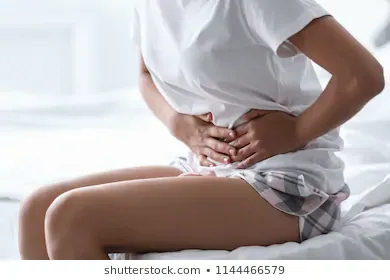How To Treat Menstrual Pains Naturally
Dysmenorrhea, also known as, painful periods, or menstrual cramps, is simply the occurrence of pain during menstruation. It usually begins around the time that menstruation begins. Symptoms typically last less than three days. The pain is usually in the pelvis or lower abdomen. Other symptoms may include back pain, diarrhea, or nausea.
• In young women painful periods often occur without an underlying problem. In older women it is more often due to an underlying issue such as uterine fibroids, adenomyosis, or endometriosis. It is more common among those with heavy periods, irregular periods, whose periods started before twelve years of age, or who have a low body weight. A pelvic exam in those who are sexually active and ultrasound may be useful to help in diagnosis. Conditions that should be ruled out include ectopic pregnancy, pelvic inflammatory disease, interstitial cystitis, and chronic pelvic pain.
Dysmenorrhea occurs less often in those who exercise regularly and those who have children early in life.
Dysmenorrhea is estimated to occur in 20% to 90% of women of reproductive age. It is the most common menstrual disorder .Typically it starts within a year of the first menstrual period .When there is no underlying cause often the pain improves with age or following having a child
CAUSES OF MENSTRUAL PAINS
Dysmenorrhea can be classified as either primary or secondary based on the absence or presence of an underlying cause. Secondary dysmenorrhea is dysmenorrhea which is associated with an existing condition.
• The most common cause of secondary dysmenorrhea is endometriosis, which can be visually confirmed by laparoscopy in approximately 70% of adolescents with dysmenorrhea.
• Other causes of secondary dysmenorrhea include leiomyoma, adenomyosis, ovarian cysts, and pelvic congestion.
• Unequal leg length might hypothetically be one of the contributors, as it may contribute to a tilted pelvis, which may cause lower back pain, which in turn may be mistaken for menstrual pain, as women with lower back pain experience increased pain during their periods.
• Other skeletal abnormalities, such as scoliosis (sometimes caused by spina bifida) might be possible contributors as well.
RISK FACTORS
You may be at greater risk of menstrual cramps if:
• You're younger than age 30
• You started puberty early, at age 11 or younger
• You have heavy bleeding during periods (menorrhagia)
• You have irregular menstrual bleeding (metrorrhagia)
• You've never given birth
• You have a family history of dysmenorrhea
• You're a smoker
SYMPTOMS OF MENSTRUAL PAINS
• The main symptom of dysmenorrhea is pain concentrated in the lower abdomen or pelvis. It is also commonly felt in the right or left side of the abdomen. It may radiate to the thighs and lower back.
• Symptoms often co-occurring with menstrual pain include nausea and vomiting, diarrhea or constipation, headache, dizziness, disorientation, hypersensitivity to sound, light, smell and touch, fainting, and fatigue. Symptoms of dysmenorrhea often begin immediately following ovulation and can last until the end of menstruation. This is because dysmenorrhea is often associated with changes in hormonal levels in the body that occur with ovulation. The use of certain types of birth control pills can prevent the symptoms of dysmenorrhea, because they stop ovulation from occurring
How To Treat Menstrual Pains Naturally
NON PHARMACOLOGICAL INTERVENTIONS
A number of self-help measures are available for women with dysmenorrhea.
• Topical heat
There is a long history of the use of heat pads and hot water bottles for the treatment of menstrual pain (Cassidy, 2001). A study by Akin et al (2001) has demonstrated that continuous low-level topical heat was as effective as oral ibuprofen for the treatment of dysmenorrhea.
• Exercise
Exercise is widely accepted as a means of moderating stress and stress-related symptoms because it causes the release of endorphins by the brain.
The mood-improving effect of endorphins may indirectly contribute to the lessening of the symptoms of dysmenorrhea. Endorphins also act directly by raising the pain threshold. (Locke and Warren, 1999).
• Nutritional Considerations First!
That’s right, getting adequate nutrition every day should be top priority! Considering that Dysmenorrhea is an inflammatory state in the body, it is important to avoid foods that increase inflammation response. High glycemic foods are known to increase levels of inflammatory chemicals in the body, including PGF2. When looked at holistically both doctors, naturopaths and herbalists agree that an anti-inflammatory diet is important.
• Avoid refined carbohydrates. Stick to whole grains like oats, millet, brown rice, quinoa, ect. Eat only 3 servings of grains at most a day.
• Eliminate sugary foods and processed sugar. Choose very limited amounts of honey or agave. Choose Stevia as a sweetner when possible.
• Consider eliminating dairy. Dairy products are congesting to the body and many doctors have seen a reduction in menstrual cramp pain in women who eliminated dairy products. If you choose dairy, try to purchase organic or organic raw dairy only to avoid added hormones.
• Reduce red meat and egg yolk consumption to at most 2-3 times a week. This is because both red meat and egg yolk are high in arachidonic acid (AA). This has been found to increase cellular inflammation in some people. To find out if you are senstive to AA, eliminate red meat and egg yolk for a month. Reintroduce it and see if your symptoms come back. Choose organic free range meats and eggs when possible to avoid added hormones.
• Eat a lot of fresh fruits and vegetables!
PHYTOTHERAPY
• When considering using herbs for painful menstrual cramps we have to consider how herbs work in the body. We have to consider the therapeutic goal of the treatment. Menstrual cramps have more to do with, than just pain. While some women have heavy bleeding with their painful period, others have a sense of stagnation, a boggy uterus with a very scant period; yet both of these can fall under a diagnosis of Dysmenorrhea. We must also consider hormonal balance, nutrition, digestion, mental/emotional state, and pain level.
HERBS FOR MENSTRUAL PAINS
• Phyllantus fraternus
• Khaya senegalensis (Mahogany)
• Alchornea cordifolia
• Alstonia boonei












